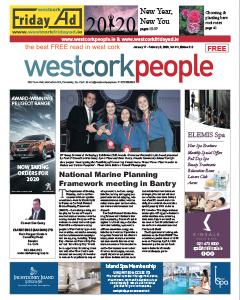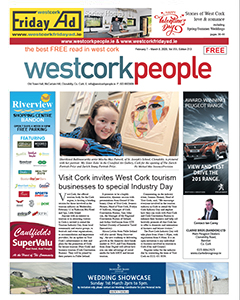It’s been an incredibly busy month across the board for Irish agriculture: The comings, goings and not knowings of Brexit, peak calving season and plenty behind-the-scenes work in Leinster house and beyond.
A bit of good news for farmers in the two western West Cork peninsulas came in the form of the department of Rural and Community development approving an eight per cent increase in payments for landowners on the Beara way and Sheep’s head way. The move will see over 600 farmers who own land on the walks benefit.
The last week of March saw the farm and myself suffer from what could be best described as an all-merciful dose of Murphy’s Law. It wasn’t just a case of anything that can go wrong will go wrong, either. It became a case of stuff you wouldn’t expect to go wrong. Thankfully, calving has been relatively trouble free.
When it’s going right farming can be one of the most pleasurable of jobs in the world. Once things start going wrong on a farm and then continue to go that way it becomes one of the loneliest, most frustrating jobs one could imagine.
Milk Price
Carbery has announced that it will be holding its milk price at 31.8c/l excluding VAT for February.
The dairy processor produces a large amount of cheddar for the UK market and is uniquely vulnerable to a hard Brexit, with tariffs on cheddar expected to hit €55m per year.
In response, Carbery has announced its intention to diversify its interests and invest €78m in a new processing facility which will create mozzarella.
The other milk processor serving West Cork, Dairygold will pay suppliers a base price of 29.6c/l, excluding VAT, for February supplies of milk. This is a cut of 1c/l on the January price.
Calves
Calves have made the headlines for a variety of reasons over the last month.
Describing the calf sale on March 11, Bandon mart manager, Tom McCarthy said: “It was like a storm Ophelia for calves. There were no boats sailing, shippers’ yards were full and it was the peak calf sale of the year.” Prices varied accordingly.
The following week weather had improved significantly and there was a solid €20 plus rise in calf prices especially for the Friesian bull calf. It was proof of how many variables can affect trade. Beef cross calves have traditionally found a solid market at home but demand for dairy cross bull calves is limited and many of these are exported to farms in the Netherlands and Spain.
However calf exports remain constrained by lairage and shipping issues. Storm Gareth forced ferry companies to refuse livestock trucks on sailings and weather hampered sailing timetables for ferries for much of the following week. Veterinary rules require that calves ferried from Ireland be rested, fed and watered for 12 hours at Cherbourg.
Minister for Agriculture Michael Creed announced that French authorities had approved additional space for 400 calves at a lairage in Cherbourg.
Minister Creed said: “Based on current ferry sailing schedules, this provides increased capacity of some 1,200 animals per week.”
Speaking to Thomas Hubert of the Irish Farmers Journal, Robert Drique, operator of the Qualivia lairage in Cherbourg, said his lairage worked at full capacity of 2,500 calves during the four weeks of March last year.
“We know there are 50,000 extra calves this year. We are short five to 10 lorries each week,” he said – which represents 1,500 to 3,000 calves. All live exporters I work with call me and say: ‘Robert, we need more’ – but I can’t.”
According to Drique, ferry sailings on alternate days would be the best way to optimise capacity, however Irish Ferries and Stena Line both sail between Ireland and France on the same days.
“Will ferry companies adjust their schedules for 2020? We will only know then,” he said.
For the year to date, calf exports are running almost 8,000 head higher than 2018.
I can understand why there are dairy farmers who say the bull calf is irrelevant to their business. It costs them time and money and it’s not their core activity. However, while the cost to the individual farmer is one thing, the cost to the reputation of Irish agriculture is what’s potentially at stake now.
The puzzle of what to do with excess dairy bull calves is not solely a legacy of the post-2015 dairy expansion. I’ve heard 1974 referenced a bit of late and how valueless calves were back then.
Just as now, some farmers received no bids for their calves in the ring. I’m reliably informed that the pub was a common stop on the way home from marts in those days. On getting home from the mart via a high stool, the unsuspecting patron could arrive home to find more calves in the trailer than they left with that morning!
While taking refuge in a pint glass and pondering what to do with their calves that no one else wanted, other farmers took advantage of the parked up cars and trailers and reduced their own calf numbers.
The animal identification system now in place means practices like this are rare.
There was a glimmer of hope in those 1974 stories too. I know of two families who ended up buying land on the proceeds of those unsellable calves, when they sold them two or three years later.
There are records from the early 17th century of calves being ‘cast out to be eaten by crows and wolves’.
Jumping forward a few years, the English agricultural writer Arthur Young, while touring Ireland from 1776 to 1779, encountered the practices within the Golden Vale. He wrote: “Vast numbers of calves are killed at two to three days old for an execrable veal they call ‘staggering Bob’, I suppose from the animal not being old enough to stand steady on its legs.”
For any foodies interested in the dish, it consisted of calf flesh scalded in water and fried with bacon.
These are examples to show surplus calves are not a new problem. It’s a dangerous position for the bovine sector to be in when there are animals that have no monetary value. As society in this country continues to move from rural to urban, the same old routine won’t suffice for anyone involved in animal agriculture. Given that we live in an era of instant communication farmers have to be more on top of their game in how stock are treated than ever before.



